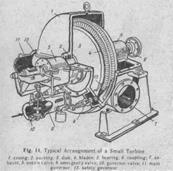Exercise 1. Get ready to answer the following sentences.
1. What types of engine do you know?
2. What is a heat engine?
3. Into what types may combustion engines be divided?
4. What is a diesel engine?
5. Where are diesel engines especially suitable?
4. What parts does a typical engines consist of?
5. What was the first engine?
Exercise 2. Explain the difference between engines: the heat engine and the diesel engine.
Exercise 3. Get ready to speak about different engines. What were the first engines used by people?
V. Reading and Comprehension
Exercise 1. Read text B „Turbines” without a dictionary and find the answers to the following questions.
1. What is the turbines?
2. What is the most readily used working fluids?
3. What is the steam turbines?
4. When did the reciprocating gleam engine come into its own?
5. In what turn tines is gas used as a working tined?
Turbines
The turbine is a machine for generating mechanical power from the energy of thestream offluid. Typical arrangement of a small turbine is shown in Fig. 11. Steam, hot air or gaseous products of combustion, and water are the most widely used working fluids.
A steam turbine maybe defined as a form of heat engine in which the energy of the steamis transformed into kinetic energy. It consists of the following fundamental parts: a) a casing orshell containingstationary blades: b) arotor,containing (In. moving blades; c) a set of bearings; d) agovernor ;andvalve system for regulating thespeed and power of the turbine. The main types of steam turbines areaxial-flow turbines andradial-stage turbines.

The reciprocating steam engine came into its own during the nineteenth century, when it found greatest use in mills, locomotives and pumping systems. The modern steam turbine, developed at the turn of the last century, is rapidly replacing the reciprocating engine for large installations. Gas is used as the working fluid in gas turbines. The basic theory underlying their design and their operating characteristics is identical with that for steam turbines. The energy of water is converted into mechanical energy of a rotating shaft in hydraulic turbines. Power may be developed from water by three fundamental processes: by action of its weight, of its pressure or of its velocity; or by a combination of any or all three.
Exercise 2. Agree or disagree with the following sentences.
1. A steam turbine may be defined as a form of heat engine in which the energy of the steam is transformed into kinetic energy.
2. There are 5 fundamental parts in a steam turbine.
3. The main types of steam turbines are axial flow turbines and radial stage turbines.
4. The modern steam turbine has developed in the XX century.
5. Power may be developed from water by two fundamental processes.
Exercise 3. Translate the sentences into Russian paying attention to the word „that”:
1. The ancient man discovered that he could easily move a rock with the help of a lever. 2. It is indeed very difficult to give a definition of science that will be as broad as we should like. 3. That the atoms in metals are packed closely together is a well-known fact. 4. It is of the utmost importancethatthe manufacturers supply engines in time. 5. It was this engine that R. Diesel patented in 1892. 6. The efficiency of the diesel engine is higher than that of the other engines.
VI. Oral Practice
Get ready to speak about different kinds of turbines. What is common and what is deferent between them?
VII. Reading